Vgamma2Vdelta2 T Cell Receptor recognition of prenyl pyrophosphates is dependent on all CDRs
- PMID: 20483784
- PMCID: PMC3069129
- DOI: 10.4049/jimmunol.1000231
Vgamma2Vdelta2 T Cell Receptor recognition of prenyl pyrophosphates is dependent on all CDRs
Abstract
gammadelta T cells differ from alphabeta T cells in the Ags they recognize and their functions in immunity. Although most alphabeta TCRs recognize peptides presented by MHC class I or II, human gammadelta T cells expressing Vgamma2Vdelta2 TCRs recognize nonpeptide prenyl pyrophosphates. To define the molecular basis for this recognition, the effect of mutations in the TCR CDR was assessed. Mutations in all CDR loops altered recognition and cover a large footprint. Unlike murine gammadelta TCR recognition of the MHC class Ib T22 protein, there was no CDR3delta motif required for recognition because only one residue is required. Instead, the length and sequence of CDR3gamma was key. Although a prenyl pyrophosphate-binding site was defined by Lys109 in Jgamma1.2 and Arg51 in CDR2delta, the area outlined by critical mutations is much larger. These results show that prenyl pyrophosphate recognition is primarily by germline-encoded regions of the gammadelta TCR, allowing a high proportion of Vgamma2Vdelta2 TCRs to respond. This underscores its parallels to innate immune receptors. Our results also provide strong evidence for the existence of an Ag-presenting molecule for prenyl pyrophosphates.
Conflict of interest statement
The authors have no conflicting financial interests.
Figures
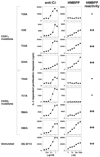
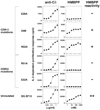
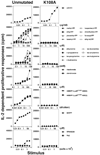
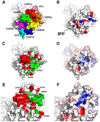
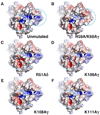

Similar articles
-
Conservation of nonpeptide antigen recognition by rhesus monkey V gamma 2V delta 2 T cells.J Immunol. 2003 Apr 1;170(7):3696-706. doi: 10.4049/jimmunol.170.7.3696. J Immunol. 2003. PMID: 12646635
-
Structural features of nonpeptide prenyl pyrophosphates that determine their antigenicity for human gamma delta T cells.J Immunol. 2001 Jul 1;167(1):36-41. doi: 10.4049/jimmunol.167.1.36. J Immunol. 2001. PMID: 11418629
-
Photoaffinity antigens for human gammadelta T cells.J Immunol. 2008 Dec 1;181(11):7738-50. doi: 10.4049/jimmunol.181.11.7738. J Immunol. 2008. PMID: 19017963 Free PMC article.
-
Antigen recognition by gammadelta T cells.Immunol Rev. 2007 Feb;215:46-58. doi: 10.1111/j.1600-065X.2006.00470.x. Immunol Rev. 2007. PMID: 17291278 Review.
-
Nonpeptide antigens, presentation mechanisms, and immunological memory of human Vgamma2Vdelta2 T cells: discriminating friend from foe through the recognition of prenyl pyrophosphate antigens.Immunol Rev. 2007 Feb;215:59-76. doi: 10.1111/j.1600-065X.2006.00479.x. Immunol Rev. 2007. PMID: 17291279 Review.
Cited by
-
Key implication of CD277/butyrophilin-3 (BTN3A) in cellular stress sensing by a major human γδ T-cell subset.Blood. 2012 Sep 13;120(11):2269-79. doi: 10.1182/blood-2012-05-430470. Epub 2012 Jul 5. Blood. 2012. PMID: 22767497 Free PMC article.
-
Vγ9Vδ2 T cells recognize butyrophilin 2A1 and 3A1 heteromers.Nat Immunol. 2024 Aug;25(8):1355-1366. doi: 10.1038/s41590-024-01892-z. Epub 2024 Jul 16. Nat Immunol. 2024. PMID: 39014161
-
Dimorphism in the TCRγ-chain repertoire defines 2 types of human immunity to Epstein-Barr virus.Blood Adv. 2020 Apr 14;4(7):1198-1205. doi: 10.1182/bloodadvances.2019001179. Blood Adv. 2020. PMID: 32211881 Free PMC article.
-
Alpaca (Vicugna pacos), the first nonprimate species with a phosphoantigen-reactive Vγ9Vδ2 T cell subset.Proc Natl Acad Sci U S A. 2020 Mar 24;117(12):6697-6707. doi: 10.1073/pnas.1909474117. Epub 2020 Mar 5. Proc Natl Acad Sci U S A. 2020. PMID: 32139608 Free PMC article.
-
Butyrophilin3A proteins and Vγ9Vδ2 T cell activation.Semin Cell Dev Biol. 2018 Dec;84:65-74. doi: 10.1016/j.semcdb.2018.02.007. Epub 2018 Mar 9. Semin Cell Dev Biol. 2018. PMID: 29471037 Free PMC article. Review.
References
-
- Cerundolo V, Silk JD, Masri SH, Salio M. Harnessing invariant NKT cells in vaccination strategies. Nat. Rev. Immunol. 2009;9:28–38. - PubMed
-
- Kronenberg M, Engel I. On the road: progress in finding the unique pathway of invariant NKT cell differentiation. Curr. Opin. Immunol. 2007;19:186–193. - PubMed
-
- Morita CT, Parker CM, Brenner MB, Band H. T cell receptor usage and functional capabilities of human γδ T cells at birth. J. Immunol. 1994;153:3979–3988. - PubMed
Publication types
MeSH terms
Substances
Grants and funding
LinkOut - more resources
Full Text Sources
Other Literature Sources
Research Materials

